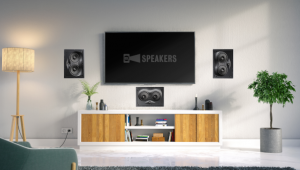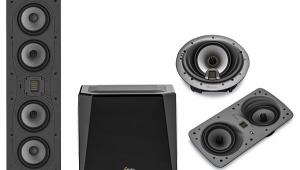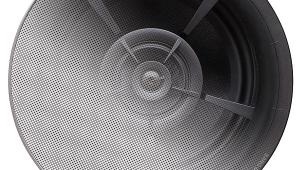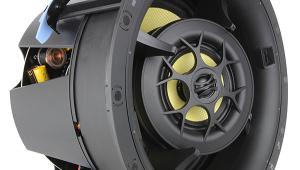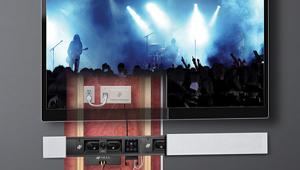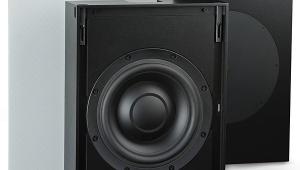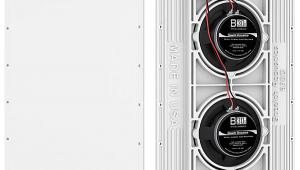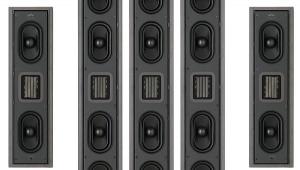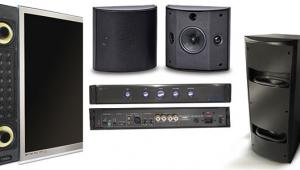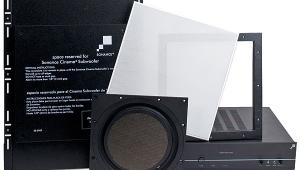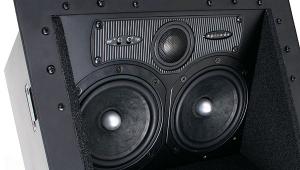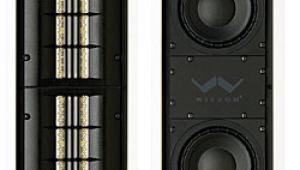FineLine LCR-21 On-Wall Speaker System Page 2
Sax on the Brain
I have to confess that the LCR-21’s plain-Jane appearance and tiny spade lugs didn’t do much to stoke my enthusiasm for trying out the system. But under the old adage, “Don’t judge a speaker by its grille cloth,” I forged ahead and gave the system a warmup with a variety of two-channel music. Pleasantly, it didn’t take long for me to warm up to the speakers. The planar magnetic tweeters are nice, open, and airy; and there’s definitely nothing shallow about the HVX midbass drivers (except mounting depth). Based on FineLine’s recommendation, I set the crossover point in my Anthem AVM 50v surround processor at 80 hertz and let the Definitive Technology SuperCube 1 subwoofer take over from there. Jones suggested that for really large rooms or very loud listening applications, you should set the crossover closer to 120 Hz. Even though I drove the LCR-21s pretty hard at times, I never felt the need to raise the setting above 80 Hz.
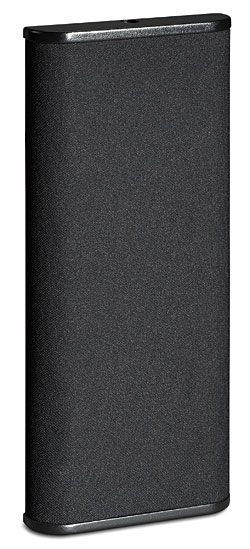 Each rush of air through John Coltrane’s soprano saxophone on the slow and moving “Mr. Syms” (The Very Best of John Coltrane) sounded focused and detailed. The tweeters were splendid, as well, in their playback of the banjo and piano—as well as Norah Jones’ voice—on “Sinkin’ Soon” (Not Too Late). The banjo was neither overly harsh nor aggressive, while at the same time, all the intricacy of the piano’s upper range came through without being softened or muted. As the track progressed, each instrument remained clearly defined, with the vocals slightly out in front. I was also impressed by the way the LCR-21s handled the delicate ring of the triangle in “Lovesong” from Adele’s 21 disc. While individual guitars play on the right and left of Adele’s chanteusey voice, there’s the barest hint of a triangle in the background. Despite its minor stature amidst the rest of the instruments, there’s no doubt that it’s there. The LCR-21 was similarly adept at maintaining the individual characteristics of the three vocals (Kid Rock, Martina McBride, and T.I.) in “Care” on Kid Rock’s Born Free disc. Overall, while the speakers were great at creating a wide soundstage, they had difficulty creating a feeling of much depth front to back.
Each rush of air through John Coltrane’s soprano saxophone on the slow and moving “Mr. Syms” (The Very Best of John Coltrane) sounded focused and detailed. The tweeters were splendid, as well, in their playback of the banjo and piano—as well as Norah Jones’ voice—on “Sinkin’ Soon” (Not Too Late). The banjo was neither overly harsh nor aggressive, while at the same time, all the intricacy of the piano’s upper range came through without being softened or muted. As the track progressed, each instrument remained clearly defined, with the vocals slightly out in front. I was also impressed by the way the LCR-21s handled the delicate ring of the triangle in “Lovesong” from Adele’s 21 disc. While individual guitars play on the right and left of Adele’s chanteusey voice, there’s the barest hint of a triangle in the background. Despite its minor stature amidst the rest of the instruments, there’s no doubt that it’s there. The LCR-21 was similarly adept at maintaining the individual characteristics of the three vocals (Kid Rock, Martina McBride, and T.I.) in “Care” on Kid Rock’s Born Free disc. Overall, while the speakers were great at creating a wide soundstage, they had difficulty creating a feeling of much depth front to back.
Your Place(ment) or Mine?
Newton’s Sixteenth Law of Visualacoustics states that any center channel mounted on the wall above or below a flat-panel HDTV must be oriented horizontally. Anyone with even a passing interest in symmetry and attractive indoor décor instinctively knows this to be true: On-wall (or in-wall) speakers on either side of a flat-panel HDTV must have a tall-and-skinny vertical orientation, while it’s a short-and-wide horizontal orientation for that oh-so-critical center-channel speaker. Case closed. Right?
Uh, not so fast, pilgrim. When I installed the center LCR-21, my initial placement was with the speaker (as Newton would have it) oriented horizontally. The front left and right as well as the surround LCR-21s were all mounted on the wall vertically (as well they should have been). Safe in the knowledge that all was right in the audio world, I switched the Anthem AVM 50v into one of its 6,000 surround modes and fired up the PlayStation 3. I started off with Memento, primarily because it had just arrived in the mail from the movie-rentals-by-mail-or-streaming-on-the-Internet company that shall remain nameless. Memento is a dialogue-heavy film. While the relatively few surround effects sounded great, the voices seemed thin and small—something I didn’t expect from the way the LCR-21s handled vocals in music.
During the opening titles of Harry Potter and the Goblet of Fire, the sound of wind starts in the left surround and moves forward, while the music seems to come from all over. I was really impressed by the way the sound of the blowing breeze maintained its identity as it shifted from the rear to the front. In several scenes early in the movie featuring Ron’s parents’ flying car, the system did a great job as the sound of the car moved around the room. And the scene when the Hogwarts Express comes up behind the car with Ron and Harry in it was just spectacular. The sound of the train rushes in from behind and swoops over you in the room. Everything, it seemed, from every musical note to the smallest cracking of a tree branch, was spot on.
Except something wasn’t quite right with the front soundstage. Instead of being a seamless wall of sound, the center channel wasn’t blending well with the left and right speakers. Rather than sounding theatrical, voices sounded, well, toyish. And then it hit me that FineLine doesn’t make a dedicated LCR-21 center channel. Now, with some speaker designs, horizontal or vertical positioning doesn’t have a tremendous effect on the sound quality from a given listening spot. But one of the drawbacks of the traditional midrange-tweeter-midrange (MTM) design—which the LCR-21 uses—is that, while the resulting dispersion pattern can be advantageous when used vertically, it can suffer from noticeably uneven off-axis response when used horizontally. In this case, reorienting the planar tweeter may have also contributed in some way. But in any event, turning the speaker on its side made the center channel sound tiny and separate from the rest of the system.
Unlike Harry Potter, I didn’t have to go to school for years to accomplish a bit of my own magic. I quickly reoriented the center LCR-21’s bracket and mounted the speaker vertically under the HDTV. The difference was quite amazing. Whereas voices in movies such as Memento had no authority or real identity whatsoever, the new arrangement gave them character and heft. For example, in Wall-E, Fred Willard’s voiceover for the Buy N Large advertisement near the beginning of the movie went from sounding weak and thin to much more ominously happy and buy-things-from-us euphoric.
The quality of the tonal balance of the voices improved. Just as impactful, reorienting the center LCR-21 created a front wall of sound instead of three fuzzy lobes. The entire front soundstage opened up, and the system finally became one seamless whole.
Straight and Center
The FineLine LCR-21 system has a lot going for it. It handled detail and nuance in music very well, in both the mid- and high-frequency ranges. When it came to movies, the integration of the front and surround channels was excellent; and the system’s ability to maintain the identity of even the smallest of sound effects was impressive. The system’s two main flaws are both visual. The first is the rather plain appearance— FineLine has some stiff competition in terms of styling with the likes of Definitive Technology and KEF out there in this relatively new ultrathin speaker category. This may not be important to you, or you may indeed like the simple appearance of the LCR-21s. The other issue is the fact that you’ll most definitely want to use the center LCR-21 in a vertical orientation. I don’t think this is something you should dismiss casually with an, “Oh, but it looks so much better on its side” line of reasoning. The difference in sound is dramatic—and drama is what we’re after with movies, isn’t it? Until FineLine comes out with a dedicated center channel that’s better designed to handle horizontal orientation, that’s simply the way you’ll need to install it.
Aside from those two issues, the LCR-21 is a great system that absolutely holds its own sonically against other systems in the price range. If you’re set on using on-wall speakers rather than bookshelf or floorstanding models (and I will no longer secretly look down my nose at you if you are), the FineLine LCR-21 system, with its 30-day money-back guarantee, is definitely worth your time. Give it a try and see how it sounds—and looks—in your room.
Ed. Note: As we went to press, FineLine’s Phil Jones acknowledged our results and indicated that a dedicated center-channel for this system with a reoriented tweeter could be on the market before year end. Bigger spade lugs for up to 12-gauge wire are also in the offing.
